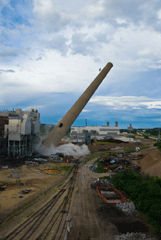Kicking Coal
Air Date: Week of February 20, 2009

The fall of coal? A decades-old smokestack at a coal-fired power plant came down last year in St. Paul, Minnesota, reported to be replaced with a lower-emission power plant. (Photo: Bree Radloff)
Plans for some 150 new coal-fired power plants have bitten the dust as uncertainty grows about how to handle coal's emissions. Now the Obama administration adds to coal's woes with steps to regulate mercury, fly ash and greenhouse gases from coal plants. Living on Earth's Jeff Young reports.
Transcript
GELLERMAN: Well despite the 3.4 billion dollar stimulus the coal industry is getting for carbon sequestration, king coal has been getting its lumps lately. As Living on Earth’s Jeff Young reports, right now, the future of coal looks black.
YOUNG: Just five years ago it was a coal rush—with some 150 coal fired power plants on the drawing board. Now, more than half are history and even more fell by the wayside in just the past few weeks. In Wisconsin, Governor Jim Doyle announced plans to power the University of Wisconsin with biomass instead of coal.
DOYLE: You know a coal plant in the middle of Madison that was there many years ago? It’s probably time to move on and not have coal.
YOUNG: In Michigan, Governor Jennifer Granholm directed state agencies to put
priority on efficiency and renewable energy instead of coal.
GRANHOLM: So here’s our next aggressive goal: By the year 2020, Michigan will reduce our reliance on fossil fuels for generating electricity by 45 percent. You heard me right: a 45 percent reduction by 2020.
YOUNG: And in Nevada, Michael Yackira, president of the electric utility NV Energy, pulled the plug on plans for a giant 15 hundred-megawatt coal burner. Yackira says questions about coal’s regulatory future made it too shaky.
YACKIRA: We are announcing that NV Energy will postpone the coal power plant project until these uncertainties can be resolved. We will not move forward until carbon capture and sequestration technologies are commercially viable.
YOUNG: Technology to strip the CO2 from coal as it’s burned, and store it in the ground is probably at least a decade away. Some doubt it will ever really work at the scale needed. CO2 emissions, and what it will cost to control them—that’s the burning issue with coal. And Sierra Club attorney Bruce Nilles spent the past two years criss-crossing the country to make sure it stayed on the front burner—firing up public interest, filing lawsuits, and talking to financiers about coal’s carbon problems.
NILLES: We beat back 84 of these proposed coal plants—again, states saying no, courts saying no and investors saying no from coast to coast. Today we have somewhere between about 70 to 80 remaining. We still have a long way to go, but we’ve come a long way from the threat we were facing.

Bruce Nilles.
YOUNG: The latest Sierra Club victory came in the form of a letter from new Environmental Protection Agency Administrator Lisa Jackson. She’s reviewing a last-minute memo from the Bush administration that gave proposed coal power plants a pass on greenhouse gases.
NILLES: For the last eight years the answer has been to put our heads in the sand and ignore carbon dioxide. And the days of pretending global warming does not exist and that carbon dioxide will not be regulated are simply over. The Obama administration is gonna use existing authorities to begin to take a bite out of global warming and do our part.
YOUNG: The EPA is also under pressure to respond to a landmark Supreme Court ruling that gave the agency authority to control CO2 as an air pollutant. And there’s growing speculation that Jackson will start doing just that before the second anniversary of that court decision on April second. Even the electric utility industry accepts the new political reality that carbon caps of some kind are coming.
Jim Owen is a spokesperson for the industry trade group, the Edison Electric Institute.
OWEN: I think they clearly have opened the door to a potential rulemaking that would, for the first time ever, regulate carbon dioxide through a regulatory process.
YOUNG: It seems coal is on the ropes right now, is that how you see it?
OWEN: How shall I phrase this? I think it is definitely true that new coal fired power plant facilities are becoming increasingly difficult to site and finance. And I think the main reason for that is well known, it has to do with what we’re talking about with the uncertainty over what is going to happen to coal-fired power generation in this country.
YOUNG: CO2 might be the headline item but it’s hardly coal’s only liability. The damage from mining, the toxic ash left after combustion, and the other pollutants coal pumps into the air—all are the subject of litigation and regulatory review. Mercury is next. EPA’s Jackson recently told reporters her agency will start work on new rules to control emissions of mercury, a potent neurotoxin that taints our waterways and fisheries.

EPA administrator Lisa Jackson.
REPORTER: Ok thank you that’s all.
YOUNG: In another significant move on mercury, the Obama administration says it will restart talks on a long-delayed international treaty limiting mercury pollution.
Utilities that use coal have never had to pay to control emissions of mercury or CO2. Those costs have instead been pushed off onto others in the form of damages to the environment and public health —what economists call externalities. If those costs are added to coal’s ledger, Sierra’s Bruce Nilles thinks it will undercut one of coal’s main selling points—the price.
NILLES: When people talk about coal being cheap—It’s not cheap. It’s having real impacts on people’s lives. And we firmly believe if you actually forced the coal industry responsible for its waste, at the end of the day coal is probably one of the most expensive fuel options possible.

The fall of coal? A 36-year-old smokestack at a coal-fired power plant came down last year in St. Paul, Minnesota, reported to be replaced with a lower-emission power plant. (Photo: Bree Radloff)
OWEN: What we are saying at the end of the day is we need a balanced portfolio. We don’t have the luxury of picking one or the other we have to make sure that the electricity is there 24 by 7 or we’re gonna hear about it. To answer your question, absolutely we think coal does and must really have a long-term future.
YOUNG: But given the fuel’s hidden costs, and the new administration’s apparent will to address them, coal’s future seems a risky bet.
For Living on Earth, I’m Jeff Young in Washington.
[MUSIC: Andrew Bird “Masterswarm” from Noble Beast (Wegawam Music/Fat Possum 2009)]
GELLERMAN: Just ahead – an inside look at the new secretary of the Interior – Ken Salazar. Keep listening to Living on Earth!
Links
EPA administrator Jackson’s letter on reviewing CO2 emissions from Bonanza Power plant, Utah.
EPA on mercury from power plants
Living on Earth wants to hear from you!
Living on Earth
62 Calef Highway, Suite 212
Lee, NH 03861
Telephone: 617-287-4121
E-mail: comments@loe.org
Newsletter [Click here]
Donate to Living on Earth!
Living on Earth is an independent media program and relies entirely on contributions from listeners and institutions supporting public service. Please donate now to preserve an independent environmental voice.
NewsletterLiving on Earth offers a weekly delivery of the show's rundown to your mailbox. Sign up for our newsletter today!
 Sailors For The Sea: Be the change you want to sea.
Sailors For The Sea: Be the change you want to sea.
 The Grantham Foundation for the Protection of the Environment: Committed to protecting and improving the health of the global environment.
The Grantham Foundation for the Protection of the Environment: Committed to protecting and improving the health of the global environment.
 Contribute to Living on Earth and receive, as our gift to you, an archival print of one of Mark Seth Lender's extraordinary wildlife photographs. Follow the link to see Mark's current collection of photographs.
Contribute to Living on Earth and receive, as our gift to you, an archival print of one of Mark Seth Lender's extraordinary wildlife photographs. Follow the link to see Mark's current collection of photographs.
 Buy a signed copy of Mark Seth Lender's book Smeagull the Seagull & support Living on Earth
Buy a signed copy of Mark Seth Lender's book Smeagull the Seagull & support Living on Earth

